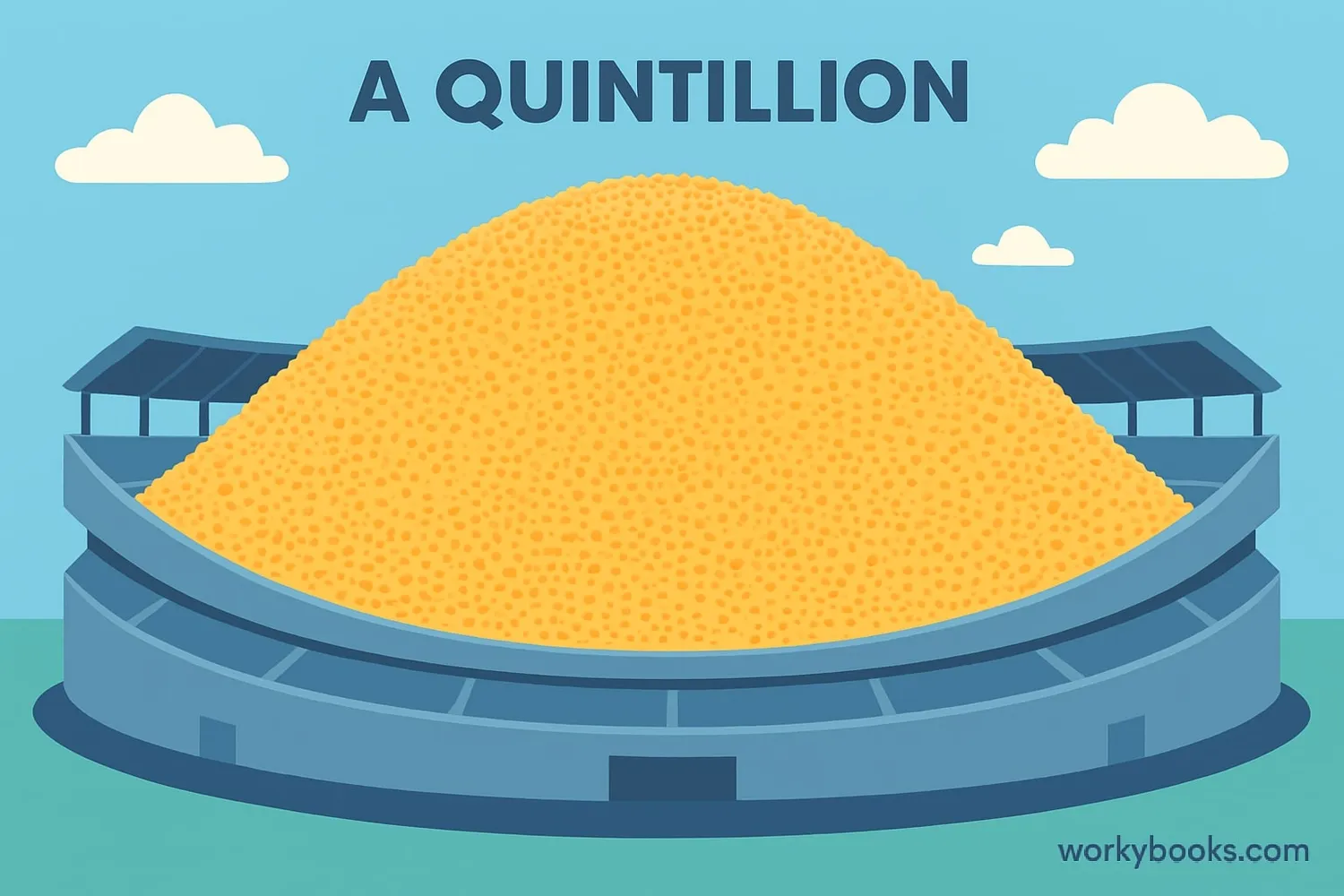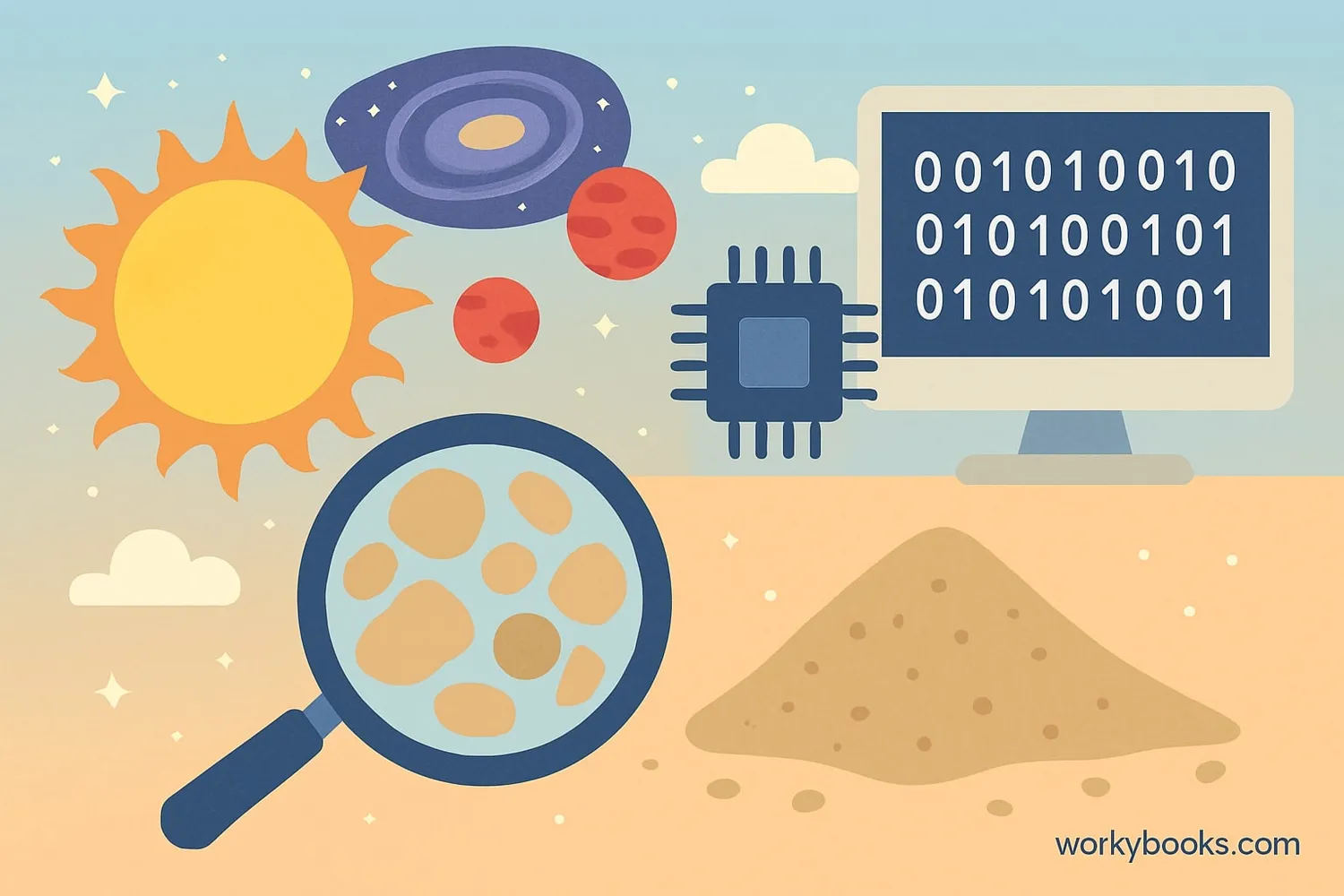What is a Quintillion? - Definition, Examples, Quiz, FAQ, Trivia
Learn about huge numbers, place value, and scientific notation with easy explanations and practice activities
What is a Quintillion?

A quintillion is a very large number that has 18 zeros! In the number system we use in the United States (called the "short scale"), a quintillion is written as:
That's one followed by 18 zeros! It's hard to imagine how big a quintillion really is. To help you understand:
- There are about 7 quintillion grains of sand on all the beaches on Earth
- Our entire Milky Way galaxy has about 100-400 billion stars - that's only 0.0000001 quintillion stars!
- If you counted one number every second, it would take you 31.7 billion years to count to a quintillion!
Key Concept
1 quintillion = 1,000,000,000,000,000,000 = 1018 (in scientific notation)
Understanding Place Value
To understand huge numbers like quintillion, we need to understand place value. Our number system groups digits into sets of three called periods:
| Period | Value | Example |
|---|---|---|
| Ones | 1, 10, 100 | 365 |
| Thousands | 1,000 | 8,427 |
| Millions | 1,000,000 | 12,000,000 |
| Billions | 1,000,000,000 | 305,000,000,000 |
| Trillions | 1,000,000,000,000 | 7,000,000,000,000 |
| Quadrillions | 1,000,000,000,000,000 | 3,000,000,000,000,000 |
| Quintillions | 1,000,000,000,000,000,000 | 5,000,000,000,000,000,000 |
Notice how each new period is 1,000 times larger than the previous one? That's why we call it the base-10 system!
Remember
Each comma in a large number separates the periods: ones, thousands, millions, billions, trillions, quadrillions, and quintillions.
Scientific Notation
Writing out quintillions with all those zeros takes too much space! That's why scientists and mathematicians use scientific notation. Scientific notation writes numbers as a coefficient times 10 raised to an exponent.
Scientific Notation Formula
Where a is between 1 and 10, and n is an integer
1 quintillion = 1 × 1018
Let's see how it works for other large numbers:
| Number Name | Standard Form | Scientific Notation |
|---|---|---|
| Million | 1,000,000 | 1 × 106 |
| Billion | 1,000,000,000 | 1 × 109 |
| Trillion | 1,000,000,000,000 | 1 × 1012 |
| Quadrillion | 1,000,000,000,000,000 | 1 × 1015 |
| Quintillion | 1,000,000,000,000,000,000 | 1 × 1018 |
| Sextillion | 1,000,000,000,000,000,000,000 | 1 × 1021 |
Conversion Tip
The exponent in scientific notation tells you how many places to move the decimal point to the right.
Comparing Large Numbers
To understand how quintillion compares to other large numbers, let's look at the number naming system:
| Number Name | Value | Relation to Quintillion |
|---|---|---|
| Million | 1,000,000 | 1 quintillion = 1,000,000,000,000 millions |
| Billion | 1,000,000,000 | 1 quintillion = 1,000,000,000 billions |
| Trillion | 1,000,000,000,000 | 1 quintillion = 1,000,000 trillions |
| Quadrillion | 1,000,000,000,000,000 | 1 quintillion = 1,000 quadrillions |
| Quintillion | 1,000,000,000,000,000,000 | 1 quintillion |
| Sextillion | 1,000,000,000,000,000,000,000 | 1 sextillion = 1,000 quintillions |
Notice that each step up is 1,000 times larger than the previous number. So:
Pattern Tip
Each number name ending with "-illion" is 1,000 times larger than the one before it.
Real-World Examples

While quintillion is an enormous number, scientists use it to measure some very big things:
Example 1: Grains of Sand
Scientists estimate there are about 7.5 quintillion grains of sand on all the beaches on Earth. That's 7,500,000,000,000,000,000 grains!
Example 2: Stars in the Universe
Astronomers estimate there are about 200 sextillion stars in the observable universe. That's 200,000,000,000,000,000,000,000 stars - or 200,000 quintillion stars!
Example 3: Computer Storage
The largest computer storage devices today can hold about 100 terabytes. A quintillion bytes (1 exabyte) would require 10,000 of these massive storage devices!
Example 4: Distance in Inches
The distance from Earth to the Sun is about 93 million miles. In inches, that's 5.9 trillion inches. You would need about 170 of these Earth-Sun distances to reach one quintillion inches!
Thinking Tip
When dealing with quintillions, scientific notation makes these huge numbers much easier to work with and compare.
Large Numbers Practice Quiz
Test your understanding of large numbers with this 5-question quiz. Choose the correct answer for each question.
Frequently Asked Questions
Here are answers to common questions about quintillions and large numbers:
Number Trivia
Discover interesting facts about large numbers:
Origin of Number Names
The names for large numbers like million, billion, and trillion come from Latin prefixes: "bi-" meaning two (billion = million squared), "tri-" meaning three (trillion = million cubed), "quad-" meaning four, and "quint-" meaning five.
Atoms in the Universe
Scientists estimate there are between 1078 and 1082 atoms in the observable universe. That's 10-100 million quadrillion quadrillion atoms!
Computer Calculations
The world's fastest supercomputers can perform over 1 quintillion (1018) calculations per second! This is called an "exaflop" in computing terms.
The Googol
A googol is 10100 (1 followed by 100 zeros). That's much larger than a quintillion! The name was invented by a 9-year-old boy, Milton Sirotta, in 1920.


